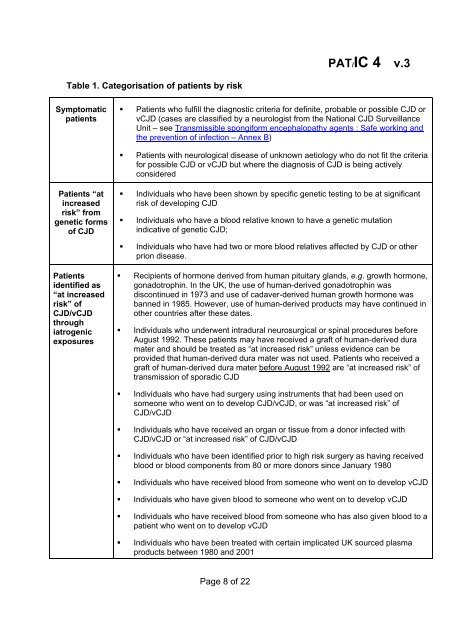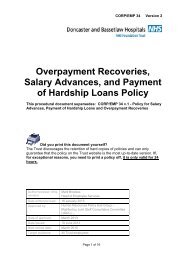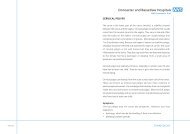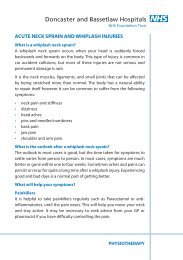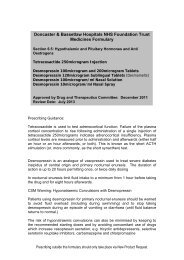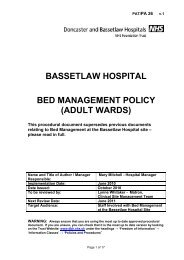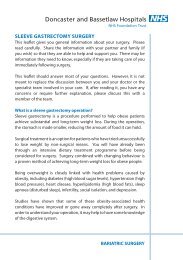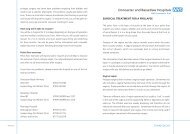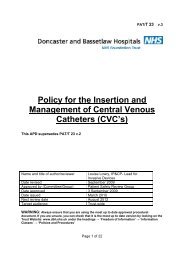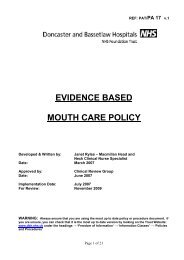VARIANT CREUTZFELDT-JAKOB DISEASE (vCJD) AND ...
VARIANT CREUTZFELDT-JAKOB DISEASE (vCJD) AND ...
VARIANT CREUTZFELDT-JAKOB DISEASE (vCJD) AND ...
You also want an ePaper? Increase the reach of your titles
YUMPU automatically turns print PDFs into web optimized ePapers that Google loves.
PAT/IC 4 v.3<br />
Table 1. Categorisation of patients by risk<br />
Symptomatic<br />
patients<br />
• Patients who fulfill the diagnostic criteria for definite, probable or possible CJD or<br />
<strong>vCJD</strong> (cases are classified by a neurologist from the National CJD Surveillance<br />
Unit – see Transmissible spongiform encephalopathy agents : Safe working and<br />
the prevention of infection – Annex B)<br />
• Patients with neurological disease of unknown aetiology who do not fit the criteria<br />
for possible CJD or <strong>vCJD</strong> but where the diagnosis of CJD is being actively<br />
considered<br />
Patients “at<br />
increased<br />
risk” from<br />
genetic forms<br />
of CJD<br />
• Individuals who have been shown by specific genetic testing to be at significant<br />
risk of developing CJD<br />
• Individuals who have a blood relative known to have a genetic mutation<br />
indicative of genetic CJD;<br />
• Individuals who have had two or more blood relatives affected by CJD or other<br />
prion disease.<br />
Patients<br />
identified as<br />
“at increased<br />
risk” of<br />
CJD/<strong>vCJD</strong><br />
through<br />
iatrogenic<br />
exposures<br />
• Recipients of hormone derived from human pituitary glands, e.g. growth hormone,<br />
gonadotrophin. In the UK, the use of human-derived gonadotrophin was<br />
discontinued in 1973 and use of cadaver-derived human growth hormone was<br />
banned in 1985. However, use of human-derived products may have continued in<br />
other countries after these dates.<br />
• Individuals who underwent intradural neurosurgical or spinal procedures before<br />
August 1992. These patients may have received a graft of human-derived dura<br />
mater and should be treated as “at increased risk” unless evidence can be<br />
provided that human-derived dura mater was not used. Patients who received a<br />
graft of human-derived dura mater before August 1992 are “at increased risk” of<br />
transmission of sporadic CJD<br />
• Individuals who have had surgery using instruments that had been used on<br />
someone who went on to develop CJD/<strong>vCJD</strong>, or was “at increased risk” of<br />
CJD/<strong>vCJD</strong><br />
• Individuals who have received an organ or tissue from a donor infected with<br />
CJD/<strong>vCJD</strong> or “at increased risk” of CJD/<strong>vCJD</strong><br />
• Individuals who have been identified prior to high risk surgery as having received<br />
blood or blood components from 80 or more donors since January 1980<br />
• Individuals who have received blood from someone who went on to develop <strong>vCJD</strong><br />
• Individuals who have given blood to someone who went on to develop <strong>vCJD</strong><br />
• Individuals who have received blood from someone who has also given blood to a<br />
patient who went on to develop <strong>vCJD</strong><br />
• Individuals who have been treated with certain implicated UK sourced plasma<br />
products between 1980 and 2001<br />
Page 8 of 22


